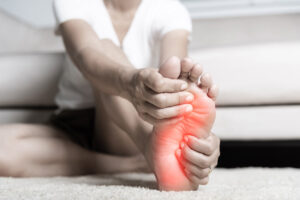What Are the Most Frequent Types and Causes of Foot Injuries? Do You Need to See a Doctor?
 Most of us are on our feet for a substantial part of our waking lives. An injury to our feet—whether a sprained ankle, stubbed toe, or pain in the Achilles—has the potential to bring our lives to a virtual standstill. What are the most common types of foot injuries? What causes most foot trauma? How are foot injuries commonly treated?
Most of us are on our feet for a substantial part of our waking lives. An injury to our feet—whether a sprained ankle, stubbed toe, or pain in the Achilles—has the potential to bring our lives to a virtual standstill. What are the most common types of foot injuries? What causes most foot trauma? How are foot injuries commonly treated?
Most Common Types of Foot Injuries
There are myriad ways you can injure your foot, but the most commonly reported injuries or conditions include the following:
- Sprained ankles—Commonly caused by overstretched or torn ligaments on the outside of your foot, an ankle sprain can make it difficult or impossible to put any weight on your foot. Mild sprains will generally heal with rest, ice, compression, and elevation (the RICE method).
- Achilles tendinitis—The Achilles tendon stretches across the back of your foot, from your heel to the back of your calf. Overstretching it can cause small tears and degeneration. The pain of mild tendinitis can be alleviated by stretching and strengthening your calf muscles. More serious Achilles tendinitis can be treated by a qualified surgeon.
- Plantar fasciitis—This involves inflammation of the tissue that connects your toes to your heel—your plantar fascia. Plantar fasciitis is frequently caused by high impact sports, weight gain, or standing on a hard surface for long periods during the work day. Stretching your foot and calf can bring relief, as can shoe inserts that elevate your heel.
- Heel spurs—Over time, you may accumulate calcium deposits on the bottom of your heel. In most instances, they can be treated without surgery, primarily through stretching.
- Bunions—Bunions are less a traumatic injury and more the result of activities that strain the ball of your foot. Any athletic activity that involves running can increase the risk of bunions. Narrow-toed or high-heeled shoes can also cause bunions. Surgery may be necessary in extreme cases, but you can often get relief with ice, foot pads, or simply by wearing shoes with a wider toe box.
- Stress fracture—Participation in any type of high-impact sports or recreational activity can cause muscle fatigue, which in turn transfers stress to your bones. That can lead to tiny cracks, which, unfortunately, can be extremely painful. Rest is typically the best medicine.
- Neuroma—If you tend to wear high heels or tight-fitting shoes, you may compress the nerves between your toes, leading to pain, tingling, and numbness. Wearing shoes with a wider toe box can help, as can orthotics, ice, and padding.
- Sesamoiditis—In the tendon beneath the ball of your foot are two small, pea-shaped bones, known as sesamoids. They can easily become inflamed by activities that put stress on the ball of your foot, such as dancing, running, or repeatedly reaching for things above your head. Anti-inflammatory drugs can help, as can athletic tape, pads, or straps.

